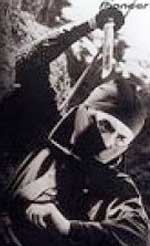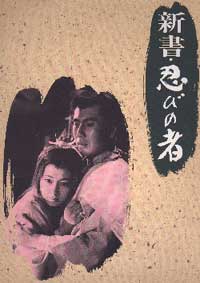This Daiei Studios black & white ninja film has an elegant look to it, with plenty of action, from a director who made some of the episodes for both the Zatoichi & Full Moon Swordsman series.
The 35 mm subtitled print I saw gave Shinsho: Shinobi no Mono the English title The Three Enemies, but it is alternatively known as The Ninja:A New Beginning, or Band of Assassins: New Writings. It is "New" because the film's star, Raizo Ichikawa, had played a ninja in a long series of films that began in 1962 with Shinobi no Mono, but The Three Enemies is a completely stand-alone film & Raizo plays a completely different ninja, though of the same general type.
 The story opens late in the Tenmon Era of civil wars when shogun Ashikage's rule was coming to a close. Three men attack a gunpowder maker in a farmhouse, the first chopping off his arm with his sickle-&-chain weapon, the second blinding him with sword, the third giving the killing blow. The story opens late in the Tenmon Era of civil wars when shogun Ashikage's rule was coming to a close. Three men attack a gunpowder maker in a farmhouse, the first chopping off his arm with his sickle-&-chain weapon, the second blinding him with sword, the third giving the killing blow.
His son Kojiro Kosume escapes the attackers as everything he has known up to then explodes into conflagration. He grows up & enters the start of the Tokugawa Era, intent on avenging his father.
Raizo Ichikawa is best remembered as the Full Moon Swordsman who was son of the black mass, but his best roles tended to be as gloomy ninjas in noirish films like this one.
Kojiro follows Chitose (Manami Fuji) when he sees her with the newly sharpened chain-&-sickle that Kojiro has never forgotten. He seduces her & through her finds Ijyuu, the sickle fighter. In their duel, Kojiro cuts off his opponent's arm, because Ijyuu had cut off the arm of Kasumi Kanbei. But it was a hard-won victory, & he is himself severely wounded, & the now one-armed ijyuu will be seen again.
Even before Kojiro is fully recovered, he enters into secret training as a ninja, & learns among other things the art of invisiblity, & participates in the rebellion against Ieyasu. During training & warfare sequences, over-obvious editing tricks are occasionally resorted to to give the impression of super-ninjas, but the tone in general remains deadly serious, & all but a few of the scenes are played no matter how extreme get playedo ut realistically.
Akane (Michiyo Ookusu, credited as Michiyo Yasuda) is a floutist & the daughter of a slain Iga spy, fostered by her father's killer. She seems not to want revenge, as she has affection for her foster father, & has seen enough of bloodshed. She is lectured to become a kunoichi (female ninja) & seek revenge. An effective scene for this character is when she dislocates bones from her joints in order to escape bonds, then resets her own bones. The sound of it is pretty gross.
When Kojiro eventually meets the second of this three enemies, he blinds him by tossing fireplace tongs (metal chopsticks) into his eyes, because that man had blinded Kasumi Kanbei. The girl Chitose sacrifices herself for Kojiro's success, living only long enough to provide a clue as to the identity of the as yet unrevealed third & final enemy. This third foe, Sadayu, turns out to be a rather heroic type rather than a worthy-of-death villain. But he respects Kojiro's thirst to avenge his father & insists on the duel, on a rooftop.
Akane's foster father has a history of having killed any ninja who falls for her, so she is adamant in saying, "I don't want to marry a spy." This is a serious barrier between Akane & Kojiro's growing affection. There is a touching scene where Kojiro gives Akane the small toy bear that is the only thing he possesses from his childhood, but in the world of ninja spies, any dream of happiness is not apt to be achievable.
But after the slaying of Kojiro's final enemy, Akane's foster father counsels Kojiro to retire from the miserable world of a shadow warrior, saying, "Let this be your last night as a spy! Take care of Akane," then sacrifices himself for Kojiro's escape.
Shinsho: Shinobi no mono is rich in plot twists, battles, duels, ninja stunts & methods, betrayals, & dismal emotions. It is a fine entry into Raizo's ninja film appearances, which really do constitute a classic era for ninja films. The various characters Raizo played in these dark, mysterious films set the tone for what it meant to be a ninja, until Japanese cinema fell into decline & ninja films became increasingly campy.
copyright © by Paghat the Ratgirl
|

 The story opens late in the Tenmon Era of civil wars when shogun Ashikage's rule was coming to a close. Three men attack a gunpowder maker in a farmhouse, the first chopping off his arm with his sickle-&-chain weapon, the second blinding him with sword, the third giving the killing blow.
The story opens late in the Tenmon Era of civil wars when shogun Ashikage's rule was coming to a close. Three men attack a gunpowder maker in a farmhouse, the first chopping off his arm with his sickle-&-chain weapon, the second blinding him with sword, the third giving the killing blow.